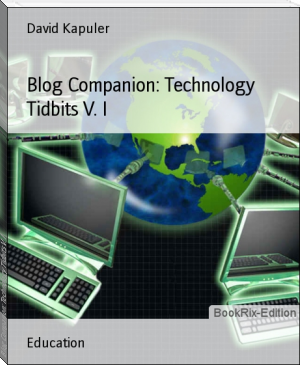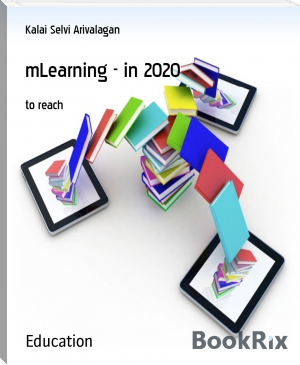INNOVATIONS IN SCIENCE, TECHNOLOGY AND MATHEMATICS EDUCATION IN NIGERIA by Ebele C. Okigbo, Nneka R. Nnorom, Ernest O. Onwukwe (the ebook reader .txt) 📖

- Author: Ebele C. Okigbo, Nneka R. Nnorom, Ernest O. Onwukwe
Book online «INNOVATIONS IN SCIENCE, TECHNOLOGY AND MATHEMATICS EDUCATION IN NIGERIA by Ebele C. Okigbo, Nneka R. Nnorom, Ernest O. Onwukwe (the ebook reader .txt) 📖». Author Ebele C. Okigbo, Nneka R. Nnorom, Ernest O. Onwukwe
Hypothesis 4
There is no significant difference between the post-test mean scores of pupils in the experimental group and those in the control group?
Table 6. The results of analysis regarding the comparison of the post-test mean scores of pupils in experiment and control groups
Groups N S Df t P
Experiment 40 82.30 10.67 76 2.670 0.011
Control 40 76.75 5.42
From the table 6 above, The null hypothesis is rejected and the researchers conclude that there was a significant difference between the post-test mean scores of the pupils in the experimental group and those in the control group (t(76)= 2.67, p>0.05).
Discussion and Conclusion
This study investigated the impact of instruction based on Classroom Assessment Techniques on pupils’ knowledge attainment in the Basic science and Technology. The pupils in both the experimental group and the control group demonstrated similar levels of knowledge about basic science and technology at the beginning of the study and no statistically significant difference was found between their pre-test scores. Following the instructional procedures, significant increases were observed in the attainment levels of the pupils both in the experimental group and in the control group. However, when the post-test scores of the pupils in the experimental group are compared with those in the control group, the attainment scores demonstrated in the experimental group were significantly higher than those demonstrated by the control group pupils. Therefore, it can be concluded that instruction using Classroom Assessment Techniques has a significant effect in enhancing the pupils’ level of attainment. This finding is supported by the findings of previous studies which have also tested the effect of using Classroom Assessment Techniques in teaching different subjects (Ashakiran and Deepthi 2013; Mansson 2013; Nartgun 2010; and Nartgun and Uluman 2009;)
Recommendations
Considering the findings of this study, the researchers recommend that Classroom Assessment Techniques should be used in different level of education as well. Further investigation might include a study of the effect of other Classroom Assessment Techniques not used in the present study on students’ attainment. Additionally, Classroom Assessment Techniques can be used and their efficacy can be tested for other subjects. Finally, the researchers suggest that Classroom Assessment Techniques should be used in senior secondary schools and higher education, particularly in the Measurement and Evaluation course.
Reference
Agrawal, D. K. and Khan Q. M. (2008). A quantitative assessment of classroom teaching and learning in engineering education. European Journal of Engineering Education, 33(1); 85-103.
Angelo, T. A. and Cross K. P. (1993). Classroom Assessment Techniques: A Handbook for College Teachers. San Francisco: Jossey-Bass Publishers.
Ashakiran, S. and Deepthi R. (2013). One Minute Paper: A thinking centred assessment to. Internet Journal of Medical Update, 8(2); 3-9.
Mansson, D.H. (2013). Assessing student learning in inter- cultural communication: Implementation of three classroom assessment techniques. College Student Journal, 47(2); 343-351
Nartgun, Z. (2010). The effect of Classroom Assessment- Techniques (CATs) based instruction on student’s competency levels of research techniques. Education and Science, 157; 113-127.
Nartgun Z. and Uluman M. (2009). Using classroom assessment to change both teaching and learning. New Directions for Teaching and Learning, 75; 23-35.
RELATIVE EFFECTIVENESS OF COLLABORATIVE AND INDIVIDUALIZED LEARNING STRATEGIES IN ENHANCING GEOMETRY ACHIEVEMENT OF SECONDARY SCHOOL STUDENTS IN ENUGU STATE, NIGERIA
Prof. Ebele C. Okigbo
&
Iheanyi O. Njoku
Abstract
Due to consistent poor performance of students in plane geometry, the researcher compared the effectiveness of collaborative and individualized learning strategies in enhancing the achievement of Senior Secondary one (SS 1) students in mathematics. Three research questions and three null hypotheses provided focus for the study. The design was quasi-experimental which employed pre-test, post–test nonrandomized groups. A total of 60 mathematics students from Afikpo Education Zone composed through simple random sampling technique (balloting) were involved in the study. Geometry Achievement Test (GAT) was used for data collection which was validated by experts and the reliability established to be 0.89 using Kuder Richardson Formula 20. Lesson plans on collaborative and individualized Learning strategies were also used as instructional tools. Mean and Analysis of covariance were used to analyze the data. The findings reveals that individualized learning strategy enhanced students’ achievement morethan collaborative learning strategy, and no significant difference exists in the achievement of male and female mathematics students taught with either collaborative or individualized learning strategies. The study recommended among others that mathematics teachers should adopt and use individualized learning strategy in teaching mathematics in order to enhance secondary school students’ achievement in geometry.
Keywords: Collaborative, Individualized learning strategies, Geometry , Achievement
Introduction
Science is both a body of knowledge and a process. Process of science involves observation, classification, measurement, inference, prediction, experimentation, hypothesizing, humility, honesty and curiosity. In school, science may sometimes seem like a collection of isolated and static facts listed in a textbook, but that is only a small part of it. Most importantly, science is a process of discovery that allows us to link isolated facts into coherent and comprehensive understanding of the natural world (Maheshappa, 2013). Maheshappa further stressed that science is a way of discovering what is in the universe and how those things work today, how they worked in the past, and how they are likely to work in the future.
Science is very important in everyday life because there is no one aspect of daily living that science has not made easier, faster or safer. Science results in technology that people rely on for health, communication and transportation. Scientific knowledge helps people understand the world from a cellular to a universal level. Science makes everyday life easier than it ever has been; for example, the scientific discovery of a method for harnessing electric energy changed people’s lives forever. Electric light benefits people every day in inventions such as traffic lights, refrigerators and communication devices. Science is the reason for the quick pace of modern life. A journey that took weeks on foot or horseback was shortened to a few days’ travel by the use of steam-powered locomotives followed by personal automobiles.
Science cannot exist on its own without mathematics. This is because mathematics is the language of science which reveals hidden patterns that help man to understand the world around him. Now, much more than arithmetic and geometry, mathematics today is a diverse discipline that deals with data, measurements and observations from science, with inference, deduction, and proof, and with mathematical models of natural phenomena, of human behavior and of social systems. As a practical matter, mathematics is a science of pattern and order. Its domain is not molecules or cells but numbers, chance, form, algorithms and change every individual requires the knowledge of mathematics to function effectively and efficiently in today’s world irrespective of the person’s job or profession. Daily, people are confronted with varied demands for mathematical competence. The housewife for instance frequently needs halving, doubling or tripling recipes consisting of such measures as 11/2 cups, 11/4teaspoon,¾ cup and so on. She also needs to prepare family budget for food and other items that would be needed in the house. She needs to compare costs and decides which article to purchase and which not to. All of these situations require ample mathematical knowledge for wise decisions to be made. Nurses or medical personnel have a lot to do with mixing substances of different strengths. They therefore should know relative sizes, volumes, weights and capacities of bottles. Business men and women also make considerations about fast selling goods to purchase and decide on price cut for slow moving items. The bus or truck driver, carpenter, painter, brick-layer, farmer and so on all have to put up with a lot of mathematical processes on quantitative situations (Adedayo in Njoku, 2017).
Mathematics is inseparable from science and technology and without mathematics; there is no science and technology. Thus Maheshappa (2013) emphasized that mathematics is considered as the “queen of sciences” which plays a vital role in technological developments. Maheshappa (2013) emphasized that for the growth of science and technology, it is crucial that there is progress in the field of mathematics. Maheshappa further explained that some of the most important problems of social and behavioral sciences were concerning arrangements, designs, patterns, sequences, schedules and assignments were made easy by mathematics. Moreover, mathematics is a practical subject. It is believed that even children at primary school level can enjoy learning of the subject, if there is a well-developed, motivating, practically oriented, appropriate and relevant method of instruction that will enhance learning. Furthermore, it is worthy of note that mathematics is a composite subject. It consists of many branches such as Algebra, Statistics, Trigonometry and Geometry
Geometry contributes immensely to helping students develop the skills of critical thinking, problem-solving ability, conjecturing, deductive reasoning, logical argument and proof. Geometric representations can be used to help students make sense of other areas of mathematics; fractions and multiplication in arithmetic, the relationships between the graphs of functions (of both two and three variables), and graphical representations of data in statistics. Geometry provides culturally and historically rich context within which to do mathematics. There are many interesting, sometimes surprising or counter-intuitive results in geometry that can stimulate students. Presenting geometry in a way that stimulates curiosity and encourages exploration can support learners’ intuition which can lead to enhancing communication and students’ learning interest towards mathematics. This would further encourage students to discuss problems in geometry, articulate their ideas and develop clearly structured arguments, skills and recognition of the importance of proofs in mathematics. Geometry has been an important source of mathematical thinking. It helps to sharpen man’s intuition and ability to think logically as well as kindle his interest in observations; it is a wonderful area of mathematics, full of surprising theorems and interesting problems. It is an integral part of cultural experience being a vital component of numerous aspects of life.
It is disappointing to find that students performed poorly in mathematics internal and external examinations in schools in Nigeria and other countries. Many students have the obnoxious notion that learning mathematics is an unattainable task. Not many school children have interest in the subject even right from the primary school level. A great majority of students believe that mathematics competence is reserved for a selected few. Unfortunately, many adults also share this feeling. It is therefore not a surprise that students continue to display lack of mathematical knowledge and perform poorly in examinations in the subject especially in the West African Senior School Certificate Examination (WASSCE), taken after secondary education. Research (Anaduaka & Okafor, 2013; Okigbo & Okoli, 2016; Okigbo & Okeke, 2018) had shown that students’ performance in mathematics has not yet significantly improved.
Some researchers suggested solution to poor performance in mathematics to be the use of innovative teaching methods, and listed some of qualities which a mathematics teacher must possess if he or she must succeed. Some of these qualities include building students’ confidence and encouraging discussion, leading students to derive rules and not memorize them (Bornstein, 2011; Protheore, 2007), good sense of humor (Burke & Dunn, 2002), use models, pictures, drawings, graphics and charts in explaining mathematical concepts and relations (Chau, 2005).
In a typical mathematics class, most talk comes from the teacher and seldom from the students. The students only pay attention or pretend to do so, copy notes, practice what the teacher has demonstrated, and then work individually to solve problems. None of these makes learning exciting and adventurous for students’ conscientious argument and discussion. Argument in search of facts in the real meaning of the mathematical process reveals thatmathematics can be learned only by doing and not by listening. So, communication with peers or teamwork could be an effective way of learning mathematics and should be encouraged. A mathematics teacher must therefore allow students talk with themselves in class and also freely talk with the teacher as well. This involves the use of either collaborative or individualized learning strategy. The present study is motivated to investigate the effects of collaborative
 The desire to acquire knowledge about the surrounding world and human society is quite natural and understandable for a person. Life is so developed that an uneducated person will never occupy a high position in any field. Humanity in its mass, and each person individually, develops objectively, regardless of certain life circumstances and obstacles, but with different intensity. The speed of development depends on the quality of training.
The desire to acquire knowledge about the surrounding world and human society is quite natural and understandable for a person. Life is so developed that an uneducated person will never occupy a high position in any field. Humanity in its mass, and each person individually, develops objectively, regardless of certain life circumstances and obstacles, but with different intensity. The speed of development depends on the quality of training.




Comments (0)